|
Tolleif
Thomsen's Imprisonment
This history is dedicated to three
people. First and foremost, in memory of my main protagonist himself,
my great-great-great-grandfather Tolleif Thomsen, but also to Tolleif
George Thomsen who wrote "Tolleif
Thomsen Saga" and to Keith Thomsen who wrote the update
"Mythic mutiny."
This story is a follow-up to those stories.
INTRODUCTION
From the stories named above I came
to know that Tolleif Thomsen was imprisoned in England during the
Napoleonic Wars and that he was involved in a mutiny, but not where
or when he was captured and where he was imprisoned. I will come
back to that below, but I will begin this history with a short background
for the whole.
In the end phase of the prolonged
Napoleonic Wars the kingdom of Denmark-Norway went to war with England
(1807-1814). Before 1807 Denmark-Norway was in a position as a neutral
shipper. England and France blockaded much of each other's imports
and exports and were sometimes dependent on products from other
countries, among them Norway, for such articles as lumber, fish
and iron for war material.
DENMARK AND NORWAY
DRAWN INTO THE WAR
Already in July and August 1807 the
English began to confiscate Norwegian and Danish ships. In the first
week of August a large British fleet lay in the Øresund.
After some days the English made a landing on Zealand Island, and
on the evening of Sept. 2, 1807, they began to bombard Copenhagen.
On Oct. 1, the total of confiscated
Danish-Norwegian ships came to 335, and on Oct. 20 the English went
home again with the whole of the Danish-Norwegian fleet as spoils
of war. For the rest I point to "Mythic
mutiny," were Keith has made a thorough research for the
time period.
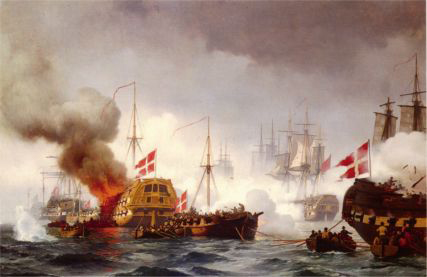
From the Battle of Copenhagen. Painting
by Neumann.
The original can be seen at Fyn's art museum in Odense.
TOLLEIF TAKEN PRISONER
The official declaration of war didn't
come until Nov. 4, 1807, but by that time many sailors had already
been captured and imprisoned, among them Tolleif.
During the time period 1807-1814 Norwegian
ships were exposed to capture; ships that broke the blockade could be
captured by a privateer, who took the crew prisoner and sent both the
ships and saliors to England. On Aug. 14 1807 the ship Welforenniet
left Bergen for a trip to Holland. They left Holland for a trip to England,
and on Sept. 1, 1807, Tolleif and other crew members were captured in
Yarmouth (Norfolk), England. Capture of a ship that broke the blockade
was regarded as a legal form of piracy, and it is possible the ship
Tolleif was aboard was one of the first Norwegian ships taken for blockade
running. His ship was taken the day before the English bombarded Copenhagen.
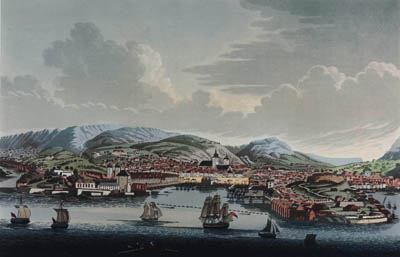
Prospect of Sandviken - Sydneshaugen in
Bergen 1807 - 1814
CAPTURE-RECORD
MICROFILM CATALOG
In the English Admiralty archive
in the Public Records Service in London you can find a register
with a catalog of war captures from the time of the Napoleonic Wars.
On the initiative of the former school chief in Lillesand, Kjell
Rosenberg, this important record of the Danish-Norwegian prisoners
was copied in 1979 to six microfilms. The microfilms have since
been available to the public both at the State Archive in Kristiansand
and Aust-Agder Archive in Arendal. A data base of some of these
records is now in the Digital
Archive posted on the Internet.
THE SHIP AND THE
CREW
|
It was mainly brigs and ketches
that were used in foreign trade. A brig is the larger of the
two ship types and was typically the ship used for voyages
to Mediterranean Sea ports and carried the biggest share of
this import and export trade. Ketches, which are considerably
smaller than brigs, were also used in foreign trade. They
were used mostly for voyages to harbors in northwestern Europe
but were also used for trips to southern Europe.
Tolleif George Thomsen wrote
that the ship Tolleif was aboard belonged to the preacher
Hans Nilsen Hauge. I haven't been able to check if this is
correct, or to find out what type of ship it was. But the
ship was called "Welforenniet" (Well United) and
was a merchant ship.
Besides Tolleif, who is entered
in the records as "Tolef
Tomsen, able seaman, 28 years old and a native of Bergen,"
I have found two other people who were with this ship:
Gullik
Pedersen, able seaman, 14, Bergen.
Torbjørn
Knudsen, able seaman, 43, Bergen. Read
more about Torbjørn.
Records of another 1,500 to 2,000
people are on the microfilms but not in the database.
|
 |
WHERE THE PRISONERS
WERE JAILED
The word prison in the records refers
not just to penitentiaries but to the prisoner of war camps operated
by the British during the Napoleonic Wars. In these camps were jailed
for shorter or longer periods men and boys of all ages. The majority
were seamen from merchant ships that had been captured by the English.
The rest were in general crewmen from Danish and Norwegian privateering
ships or members of the Danish-Norwegian navy.
|
|
Some soldiers, many from the
Danish islands of St. Thomsas and St. Croix in the Caribbean
Sea, were also found among the prisoners. The biggest single
group taken to prison at one time were crewmen from the warships
Prince Christian Frederick, Denmark-Norway's last usable navy
ship, which surrendered off Zealand Cape on March 22, 1808.
About 370 of the crew were then taken to prison in England.
The PRINCE CHRISTIAN FREDERIK's
last fight.
|
There were two main types
of prison camps, land prison and ship prison.
LAND PRISON
Land prisons can be divided into
open and closed (or locked) land prisons. On prison ships and in
the closed land prisons, the captives were kept under lock and key
with military guards and mainly at the expense of the English. In
the open land prisons, trustees or parolees were kept at their own
expense, but with a per-day grant or subsidy from the Danish government.
All prisoners got something, but the parole or trustee prisoners
got a little more. These prisoners also got some privileges and
could move about more freely, but they had to swear that they wouldn't
try to escape. The open prisons were mainly used for navy and other
military officers, some civilians, and higher ships officers from
the merchant fleet. They had the right to bring with them a servant,
usually a boy. The main group of parole prisoners were ship captains
and mates with their servants or cabin boys.
Land prisons were scattered widely
around Great Britain. The most important camps were in Reading,
about 50 km west of London, and Ashburton, in Devon about 30 km
northeast of Plymouth. Other such camps were in Moreton Hampstead,
Northampton and Peebles (in Scotland). The largest closed or locked
prison was in Greenlaw in Scotland near the small city of Pennyquick,
now called Glencorse Barrack, about 15 km south of Edinburgh. Of
lesser importance were Bristol, Yarmouth and Bishop's Waltham. Other
closed or locked land prisons mentioned were Norman Cross in Huntingdon,
which was the first camp especially for POWs, and Dartmoor in Devon,
where the majority of prisoners were French.
TOLLEIF IN SHIP PRISON
|
Most of the officers from privateer
ships and most of the Danish-Norwegian prisoners were, however,
placed in the infamous prison ships in the bay out from the
small towns of Chatham and Gillingham (near the mouth of the
Thames River), Plymouth in Devon and Portsmouth in Hampshire.
Mention must also be made that 200-300 were held on the British
island of Barbados in the Caribbean during the first three
or four months of 1808, while more than 1,200 people were
imprisoned at Gothenburg, Sweden, from late winter
or spring 1809 until early the same fall (Sweden had concluded
an alliance with England on Feb. 2, 1808).
After a while, the biggest
share of the Danish-Norwegian prisoners were collected in
Chatham, Plymouth and Portsmouth. The notorious, stinking
prison ships were old navy vessels, partly of English origin,
partly captured French, Spanish, Dutch and Danish ships. They
were anchored in a row in the waters off the ports, without
masts or tillers and isolated from land.
|
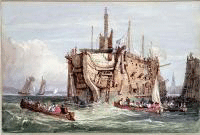 Ship Prison
Ship Prison |
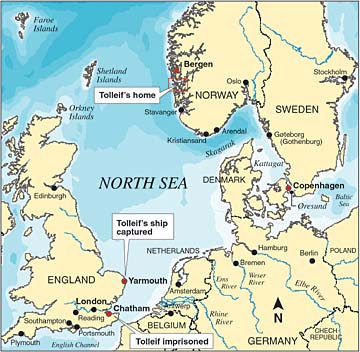
Tolleif was, as mentioned, captured in
Yarmouth and was probably held there to begin with in the locked land
prison, but he and the two shipmates I named earlier were transfered
to Chatham Dec. 03, 1807. Near Chatham-Gillingham lay 12 prison ships
and a hospital ship. Which of these dreadful vessels Tolleif was aboard
I don't know, but the 12 ships were named Fyen, Kronprins Fredrik, Nassau
(earlier Holsten), Crusty, Sampson, Buckingham (later replaced by Brunswick),
Irresistible, Bahama, Canada, Glory and Belliqueux. The first three
were captured near Copenhagen in, respectively, 1807, 1807 and 1801.
In Plymouth there were first eight, then
12, ships in addition of a hospital ship: Prince, Panther, Bienfaisant,
Brave, St. Nicolas, Europe, St. Isodore, Hector, Fame, Ganges, Genereux
and Oiseau. Of the eight more ships at Portsmouth only the names Proteus,
Niger and hospital ship Gladiator are known. In Gothenburg was the English
prison brig Nelly. The prison ships were under the jurisdiction of the
English Admiralty. The control agency was the so-called Transport Office
or Transport Board.
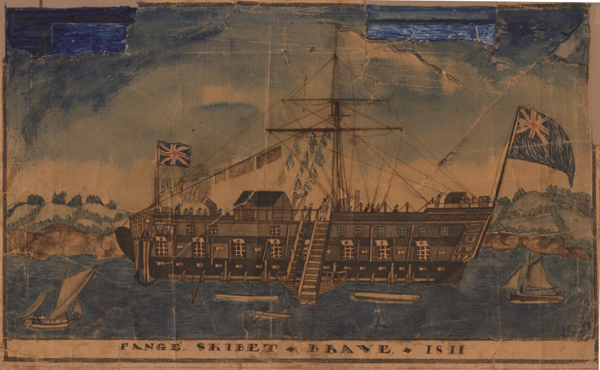
The prison ship Brave. Drawned
by the Norwegian prisoner Elling Fransen of Dybvaag. He, being a prisoner,
was held captive, and allowed shoreleave on a limited basis. By using
colors from rocks and materials from the shore, he was able to paint
this picture of the ship.
.
TOLLEIF IS TRANSFERED
Tolleif was kept on one of the prison
ships near Chatham. In most of the prison champs, the sailor-prisoners
were continually under pressure from the English to enter English
service in return for promises of release. A considerable share
of the Danish-Norwegian war prisoners took the offer of berths on
English merchant ships, most likely on East Indian ships. This manner
of gaining release from captivity was disliked and disdained by
the remaining prisoners and by public opinion in the homeland, but
taking jobs on merchant ships was not yet considered treason. A
good deal worse was to accept duty aboard a warship. Norwegians
and Danes found aboard English navy ships by their countrymen was
"rewarded" with a court martial. The Norwegian-born priest
Ulrik Fredrik Rosing, who worked among prisoners until 1811, estimated
that about 300 of the 7,000 prisoners went into English service,
less than five percent.
Tolleif was jailed along
with the other prisoners aboard the prison ships. The data base shows
that some were shot, while others died of different diseases, such as
typhus, gangrene, hemorrhage, etc. Under these inhuman conditions Tolleif
was held until Jan. 17, 1809. He was then, ironically enough, transferred
to a ship with the name Better Times. It is possible that this was the
ship he was aboard when the Norwegian prisoners mutinied on the way
from Iceland to England (See "Tolleif Thomsen Saga" and "Mythic
Mutiny). ID
563 Christian Christiansen were also transfered to the ship 'Bedre
Tider'.
According to Tolleif George, Tolleif
was in prison for 2 1/2 years, but the period I describe above is
from Sept. 1, 1807, to Jan. 17, 1809, just a scant 1 1/2 years.
Certainly Tolleif could have been aboard the ship a year before
the mutiny, or it could be another prison ship.
Additional research will give us
answers, but we have now come a long bit on the way. As mentioned
earlier, the six microfilms contain information that is not in the
Digital Archive. These microfilms should contain some very interesting
information about Tolleif.
This is what I found on the microfilm:
Chatham, ADM 103/61 nr. 670:
-Number. 670
-By what Ship, or how taken. A Cutter
-Time when. 01 September 1807
-Place where. Yarmouth in Norfolk, England
-Name of Prize. Welforenniet
-Whether Man of War, Privateer, or Merchant-Vessel. Merchant-Vessel
-Prisoners Names. Tolef Tomsen
-Quality. Seaman
-Time when received into Custody. 03 December 1807
-From what Ship, or whence received. Wool..t (Woolwat ?)
-Place of Nativity. Nth. Bergen
-DESCRIPTION.
-Age. 28
-Stature. 5/ 4 1/2
-Person.
-Visage and Complexion. Oval, P..l
-Hair. Red
-Eyes. Blue
-Marks or Wounds. Pimpled
-Exchanged, Discharged, Died, or Escaped. Discharged
-Time when. 17 January 1809
-Whither, and by what Order if discharged. Bedre Tider
Written by
Roger Fossum
Translated by
Keith Thomsen
Copyright © 2003 - 2024, Roger
Fossum postmaster@slektsforskning.com
All right reserved. (http://slektsforskning.com/index.htm)
|



